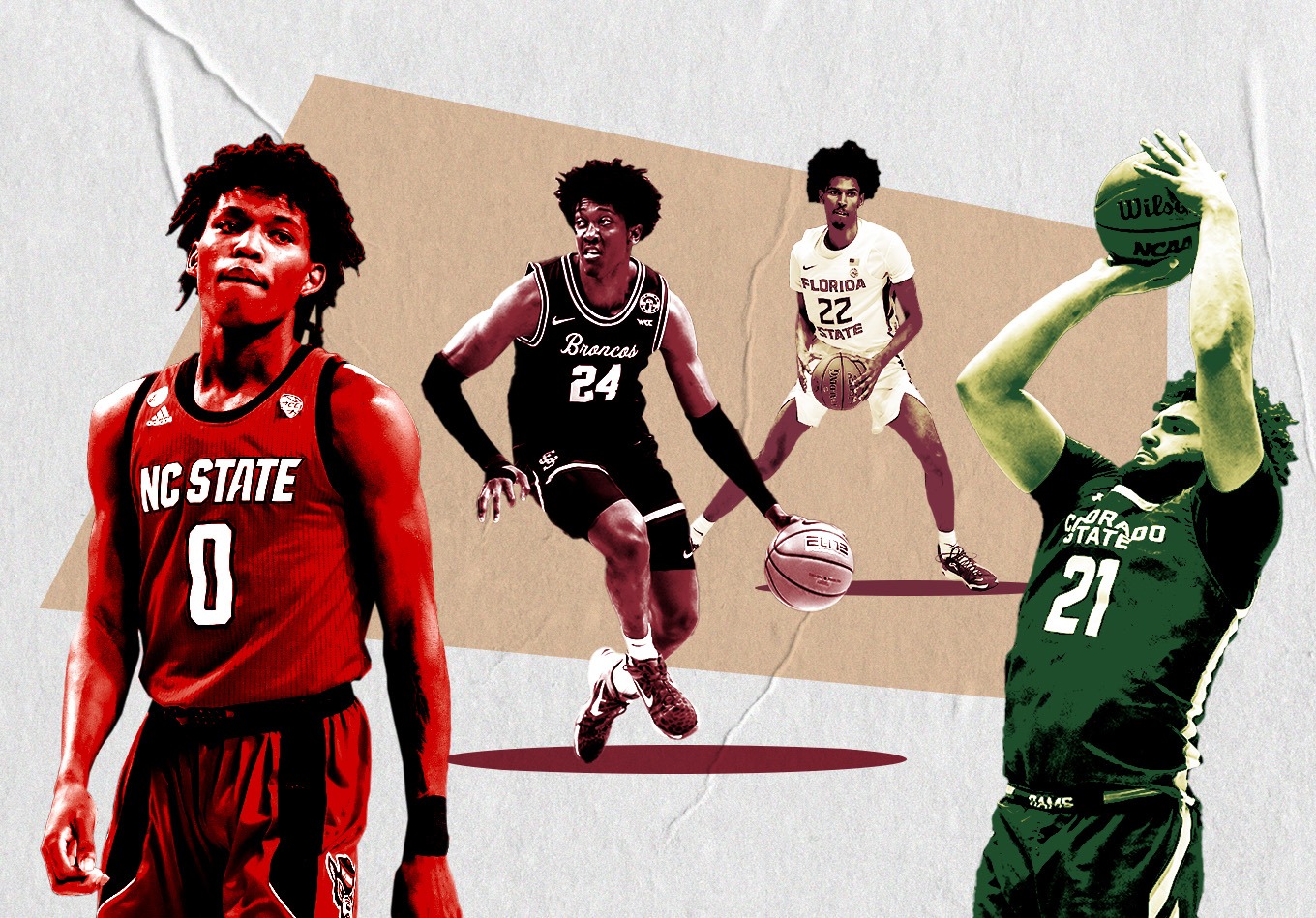The NBA Draft Combine and NCAA early entrant withdrawal deadline have come and gone, and we are now less than three weeks until draft day.
Let’s take a dive into some of the most consequential stay/go decisions of the past week that are poised to significantly shape the 2022 and 2023 NBA Drafts.
Staying In: Jalen Williams, Santa Clara
It’s easy to understand why Williams wasn’t considered a big time NBA prospect ahead of the 2021-22 season after a sophomore campaign in which he shot less than 40% from the field and less than 30% from 3 in the WCC. He contributed positively in other ways, but there simply weren’t all that many viable indicators that he was on a trajectory toward prospect relevance.
Early last season, however, it became apparent that Williams had made tangible improvements to his game. In the Broncos’ eight-game November slate, Williams averaged 19.1 points, 4.0 rebounds, 3.6 assists and 2.1 steals on 53.9/39.1/87.2% shooting splits, including a 22-point, six-rebound, five-assist performance in a victory over TCU in the SoCal Challenge. He started garnering underground buzz, but Williams remained fairly under the radar through his March 31st draft declaration.
Though his draft buzz was already elevating as scouts and evaluators took the time to catch up on his tape in April, Williams took another step out of the shadows with his performance at the NBA Draft Combine. He finished with 30 points on 12-of-16 shooting – including 3 of 3 from the foul line – to go with eight rebounds, a steal and a block on 86.6% true shooting in 49 minutes played across two scrimmage victories.
Safe to say, he made the most of his opportunity that a staggering number of prospects opted out of participating in. Williams got out there, competed, turned the heads of NBA executives, and has now skyrocketed past many of the prospects who didn’t play in the eyes of potential draft suitors.
Williams on-court brilliance was matched by eye-popping measurables. While anthro measurements and athletic testing aren’t the be-all-end-all and their functional application on the court is paramount, it’s worth noting the absurdity of Williams’ measurements and athletic testing – both of which jump off the page.
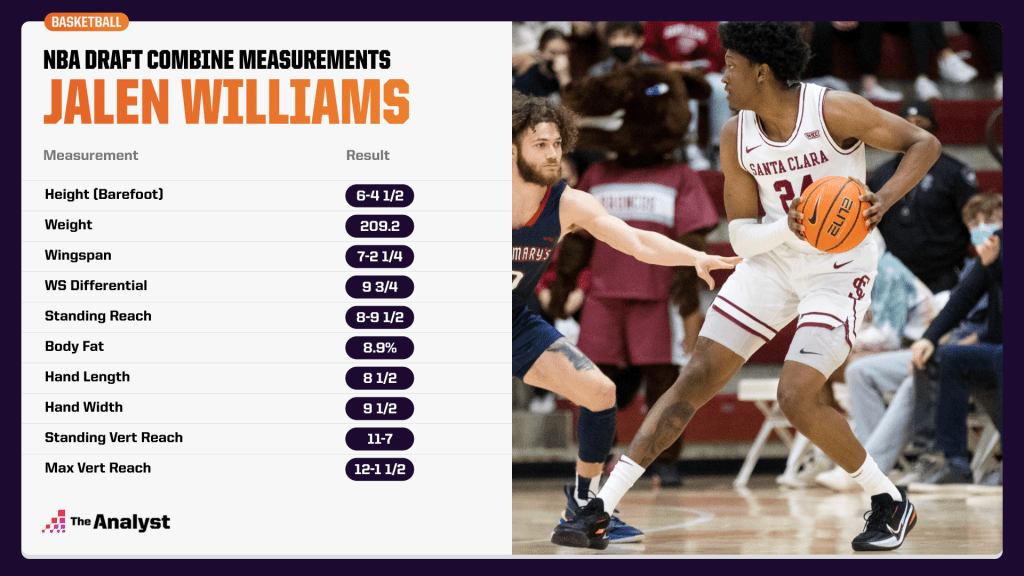
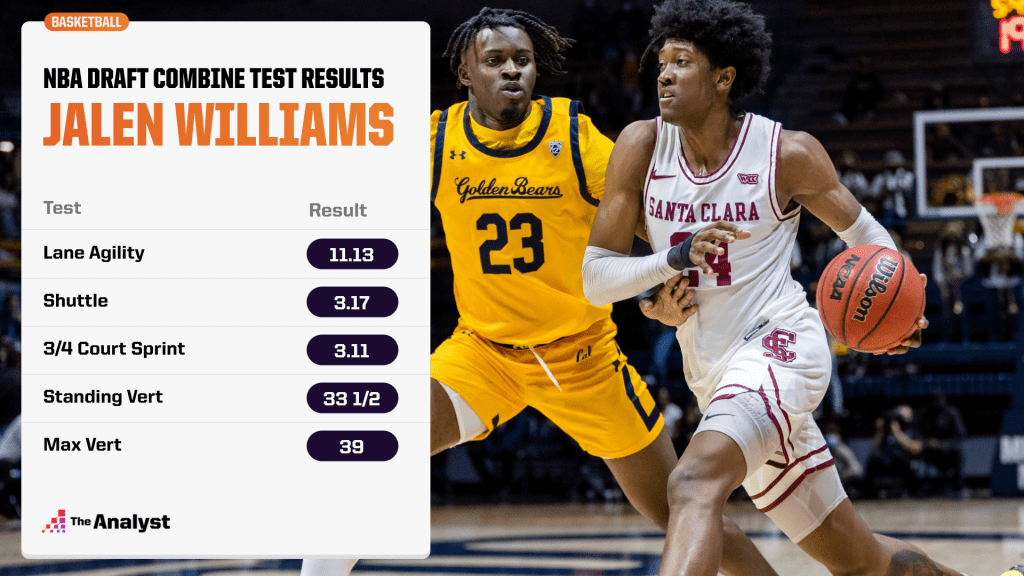
Let’s put some context on these numbers. Williams’ 9-foot ¾ wingspan differential is the largest in this draft class and the second largest of the past two drafts, trailing only EJ Onu.
His 7-foot-2 ¼ wingspan is the same as OG Anunoby’s at the 2017 NBA Draft Combine. The 39-inch vertical and 3.11 second three-quarter-court sprint were each top-five marks at this year’s combine.
Put simply, this guy is a freak of an athlete with the game to match.
One element of his game that consistently stands out is his ability to create advantageous situations for himself and teammates by getting downhill on drives. Among consensus first-round prospects with at least 175 AutoStats-tracked drive chances, Williams ranks second by deriving 0.928 points per drive chance for his team.
AutoStats collects comprehensive tracking data from any game through any television broadcast, generating a great deal of new information available on NBA draft prospects.
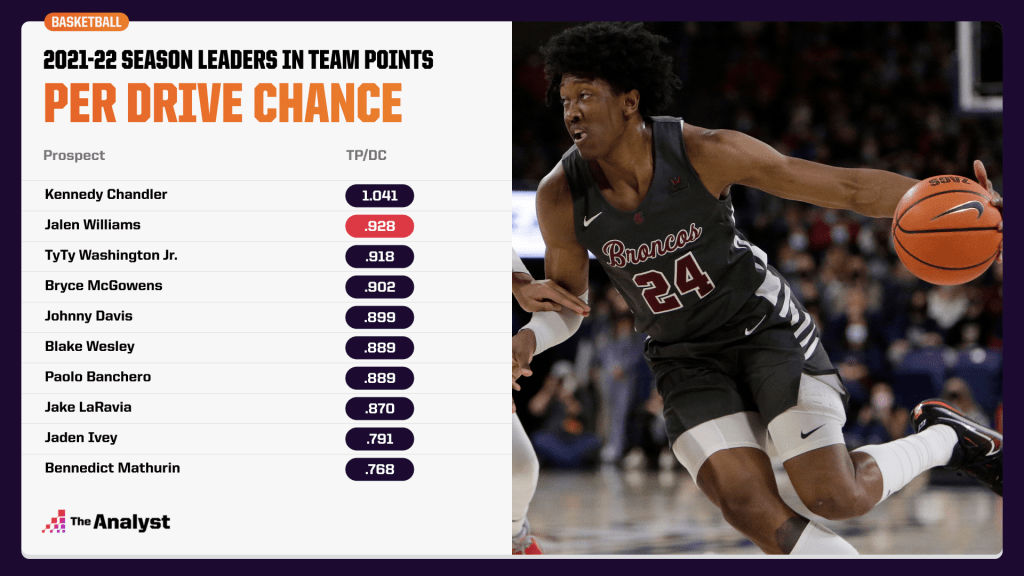
It’s also worth noting that Williams had the most even left/right directional drive split of this group, making it a bit more difficult on opposing on-ball defenders to shade him a given direction or jump his likely path to the paint.
Williams noted his intent to stay in the draft on May 28 shortly following the BDA Sports Pro day in Santa Barbara and currently projects as a mid-to-late first-round selection.
Staying In: David Roddy, Colorado State
Roddy is a fascinating, uniquely built prospect who, similar to Williams, was a productive mid-major player as a freshman and sophomore, but didn’t burst onto the draft radar until a notable junior season leap. While he also showed growth in other areas, Roddy’s ascension to draft relevance was primarily driven by a sharp rise in 3-point shooting. He knocked down 43.8% of his 3s as a junior after shooting a combined 23.5% over his previous two seasons.
He’s also shown confidence and versatility as an off-the-dribble pull-up shooter, but it’s fair to still question the stickiness of this shooting bump. Our draft model certainly does. Is he a 40-plus% shooter from deep in the NBA? Unlikely. But if he can settle somewhere slightly above league average and remain a viable gravitational threat from the perimeter to stretch opposing big men out of the paint, he has a chance to stick.
Roddy had some strong draft momentum heading into the pre-draft process, but this was slightly curbed by his combine performance. Roddy was 5-of-17 from the field, missed all six of his 3-point attempts, and had more turnovers than assists. He racked up four steals and two blocks across two scrimmages, but he wasn’t necessarily a defensive game-changer. There remains some skepticism as to exactly who Roddy viably guards at the NBA level.
He’s a somewhat difficult prospect to project given his unique frame (6-foot-4 ½ barefoot, 260+ lbs) and game. Roddy’s closest comparisons per our NBA Draft model include an array of fringe players: Tyler Cook, Reggie Perry, Trendon Watford and Jarrell Brantley.
But there seems to be something there that just might work.
Roddy will need to reallocate some of his substantial diet of post-up possessions elsewhere, likely further engaging his offensive versatility to function as a short-roll facilitator or dribble hand-off hub when called upon. He’s proven capable of using his strong, wide frame as a ball screener to create ample separation for ball handlers and drive efficient offensive possessions.
Roddy is one of only six consensus top-100 prospects with greater than 50 AutoStats-tracked chances as a direct ball screener in which his team converted at a greater than 1.0 point per chance clip.
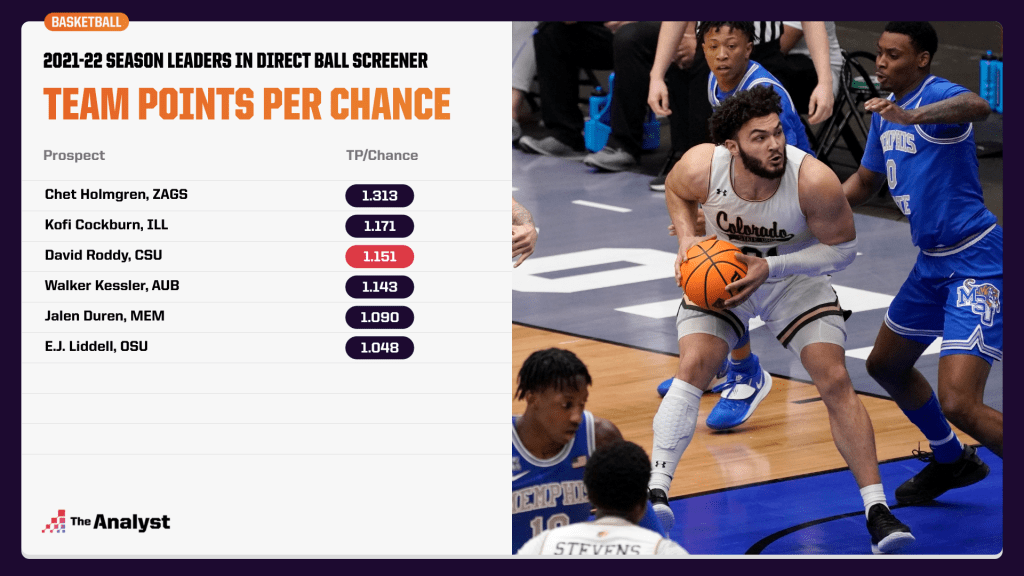
Roddy is five inches shorter, on average, than these other five elite screen setters.
When it’s all said and done, Roddy’s combination of power, skill and adaptability should give him a shot of carving out a niche NBA role.
Staying In: John Butler, Florida State
Butler’s frame is the polar opposite of Roddy’s, but even more of a unique spectacle, measuring in at 7-foot ¾ in shoes and only 174.4 pounds. Sure, he has a long neck, but it’s hard to believe this is even physically possible, let alone that someone with that build could be a legitimate NBA prospect. As it turns out, he is.
I scouted Butler’s first collegiate start back in November when the Seminoles made the trip to West Lafayette to take on Purdue.
I tabbed him as a “long-term” prospect in this tweet as it was apparent that his combination of knockdown 3-point shooting and lateral mobility as a perimeter defender gave him real NBA upside, but I certainly didn’t think he’d be ready to contribute in an NBA rotation for at least a couple of years.
I still tend to feel this way and am surprised that Butler kept his name in the draft, but I think he remains an enticing draft swing for a team that is willing to be patient and purposeful in his development. He’ll likely need to spend significant time in the G League and require very regimented nutrition and strength programs to have a chance of achieving his potential.
But okay, he’s skinny, we all get it…that’s something he’ll have to address,, but let’s focus on what he CAN do.
Butler is one of only seven consensus top-100 prospects to shoot 40+% from NBA 3-point range on more than 50 attempts.
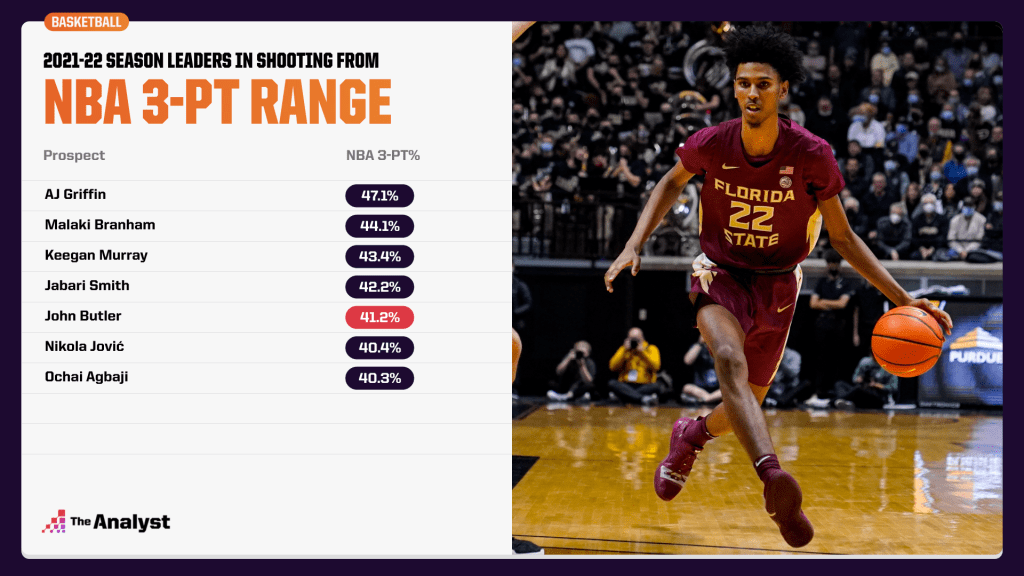
The rest of these prospects have all been tabbed as lottery picks throughout the course of this draft cycle.
Butler also Joins Chet Holmgren as the only 7-foot+ freshmen in the past 15 years to eclipse the following statistical thresholds:
- 5.0+ block percentage
- 35.0+ 3-point percentage on 5.0+ attempts per 100 possessions
Is he Chet Holmgren? Almost certainly not. But his size and skill set is truly rare.
And it’s not just shot blocking and shooting…Butler’s ability to move his feet on the perimeter, recover on drivers, and prevent players from even attempting shots at the rim is really appealing.
Among 6-foot-10+ consensus top-100 prospects with 50+ direct drives defended per AutoStats tracking data, Butler ranks third in the percentage of his drives defended that result in pull-outs, joining Chet Holmgren and Walker Kessler as the only to force a 25.0+% pull-out rate.
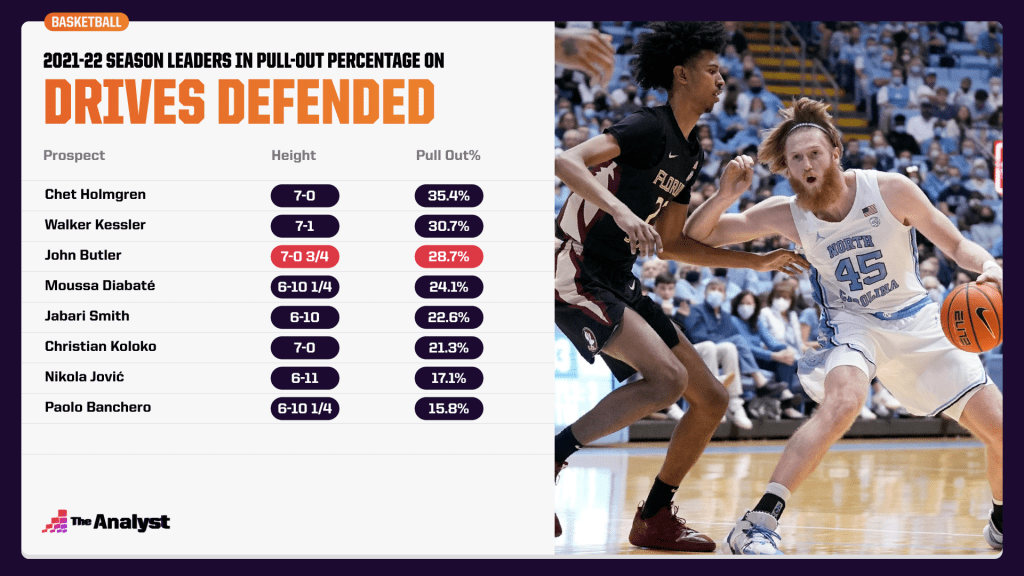
In reviewing the tape, Holmgren and Kessler’s rates stem primarily from traditional rim-protection prowess and shot blocking intimidation. Butler brings a bit of this, but his rate is more so driven by his movement skills, ability to cut off angles, and then his gangly height/length only catalyze his effectiveness.
Drivers think they can get past him, get cut off, and then Butler’s arms both prevent viable angles for pull-ups or kick-outs.
I had the opportunity to see Butler again during NBA Combine week at the Roc Nation Sports Pro Day.
His fluidity was on full display and he didn’t look out of place working out with more traditional guards. He will likely function as more of a bizarrely tall guard/wing in the G League until he’s able to pack on enough weight to slide down to his optimal role as a stretch four rim-protector.
Withdrawing: Terquavion Smith, North Carolina State
While Smith finished as a top-100 recruit in his high school class, he wasn’t remotely thought of as a likely one-and-done candidate. Despite routinely torching ACC opponents as a true freshman, it took a while for NBA teams to buy into Smith due to his thin frame, lack of pedigree and NC State’s poor season.
I had the opportunity to scout Smith back in January when NC State made the trip to South Bend to take on Notre Dame.
It turned out to be one of Smith’s roughest games in conference play, scoring only one field goal and committing four turnovers. Despite the struggles, it was apparent that Smith was quite talented and that an NBA future could be in the cards.
Smith followed that rough performance up with a 34-point outburst in Chapel Hill. He went on to score 20+ points in six of his final 10 games of the season. Smith’s stock was on the rise at the right time, and he kept that going into the NBA Combine. Smith led all scorers with 17 points in the first scrimmage in Chicago and ultimately decided to shut things down after that. All of this felt very Bones Hyland-esque, and most thought it likely that Smith would keep his name in the draft as a likely late first-round selection.
Despite all of this positive momentum and his top teammate, Dereon Seabron, deciding to stay in the 2022 NBA Draft, Smith elected to withdraw his name and return for his sophomore season. While this was fairly surprising, Smith will likely be projected to be chosen in the middle of the first round of the 2023 draft.
Smith’s primary value proposition as it relates to his NBA translatability is his shooting versatility. He’s able to get hot quickly and is capable as both a dynamic off-the-dribble shot creator and as a floor-spacing knockdown catch-and-shooter when functioning off the ball.
While Smith was able to put these perimeter scoring chops on display as a freshman, it didn’t necessarily translate to efficiency or winning basketball. The context of his role and usage didn’t necessarily set him up for success as a freshman, but there’s certainly room from improvement as a sophomore to give NBA decision makers more assurance that he warrants a first-round selection.
Improvement Area No. 1: Finishing At The Rim
Per AutoStats tracking data, Smith’s drives ended with a jumper attempt 37.8% of the time, the highest mark amongst consensus top-100 prospects with at least 100 tracked drives. While this is undoubtedly, in part, necessitated by NC State’s lack of floor-spacing, it’s also because of Smith’s lack of physicality in getting to the rim. Smith weighed in at just over 165 pounds at the NBA Combine and could stand to add both upper and lower body strength so he can get to the rim at a higher frequency and finish at a better clip (shot only 50.0% at the rim as a freshman).
Improvement Area No. 2: Defense
Among consensus top-100 prospects with 500+ AutoStats-tracked defensive chances, NC State’s points surrendered per defensive chance with Smith on the court trailed only the New Zealand Breakers when either Hugo Besson or Ousmane Dieng were on the court.
While this is primarily a team-based stat, Smith was often the one opening the floodgates as a lackluster perimeter defender. While he clearly needs to add strength to hold up better physically in containing his on-ball matchups, he could also stand to become more consistently engaged as an off-ball team defender. Smith has the requisite speed, quickness and athletic pop to survive on the defensive end, so making these improvements would go a long way in convincing NBA evaluators that he can stay on the court at the next level in high leverage situations.
Improvement Area No. 3: Pick-and-Roll Playmaking
Among consensus top-250 prospects with 200+ AutoStats-tracked chances (37 prospects) as a pick-and-roll handler, Smith ranked dead last at 0.662 team points per chance. While he’s got the shot-creation juice to sometimes make something out of nothing by knocking down difficult looks, he settles for them far too often and isn’t actively seeking opportunities to create for others. Even if he doesn’t make a quantum leap as a rim-attacker, Smith’s shooting gravity and quickness should be enough to warp the shape of the defense and create ample advantages for teammates. He just needs to sharpen his split-second decision making and willingness to look for such playmaking opportunities.
If Smith tangibly develops in multiple of these improvement areas as a sophomore, look out.
Graphic design by Briggs Clinard.
Enjoy this? Subscribe to our mailing list to receive exclusive weekly content.
